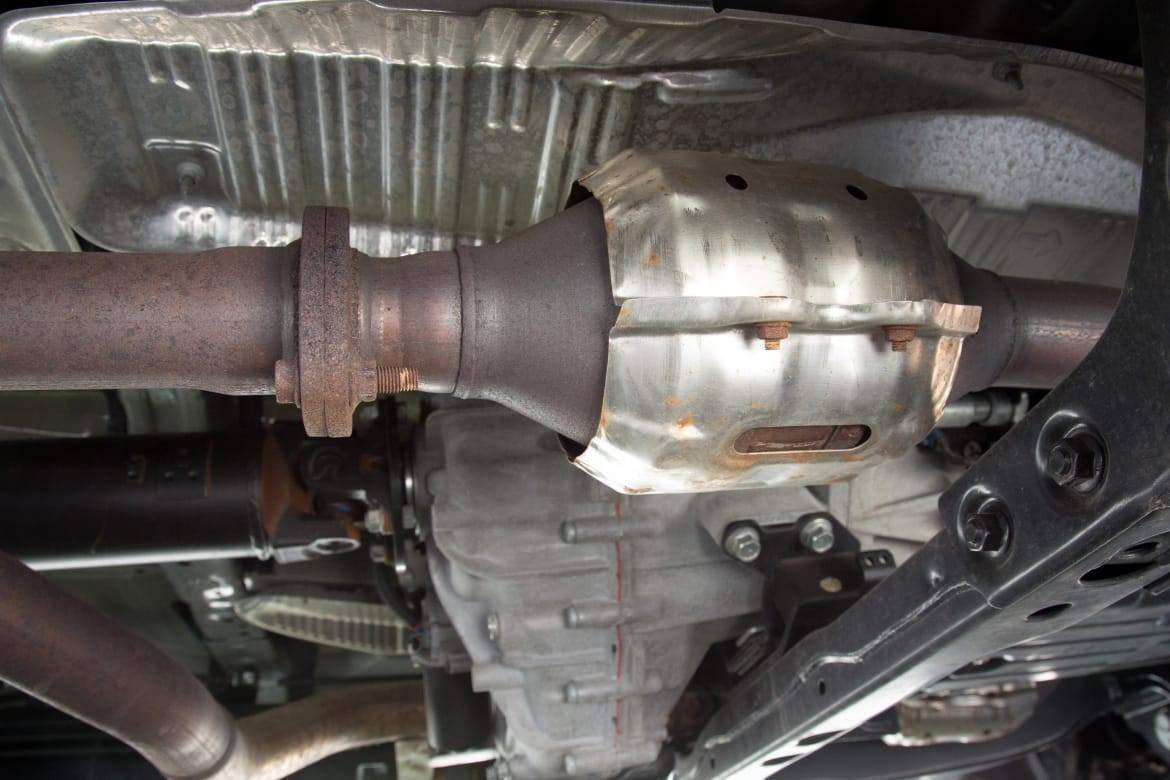What's a Catalytic Converter and Why Do People Steal Them?

A catalytic converter is an integral part of a car’s overall exhaust system. However, while they are normally something a car owner would never think about, thefts of catalytic converters spiked to unprecedented levels several years ago.
Related: What Are Common Catalytic Converter Problems?
Why Do Cars Have Catalytic Converters?
Catalytic converters rapidly became part of the automotive landscape after the Clean Air Act of 1970 was enacted and formed the EPA. The EPA was given authorization to enact federal and state standards for everything including cars and trucks.
Located between the engine and rear muffler, a catalytic converter is tasked with taking harmful engine emissions and converting them into less harmful exhaust. The worst hydrocarbons, carbon monoxide and nitrogen oxides in the exhaust are transformed through a chemical reaction into less harmful carbon dioxide, nitrogen and water vapor. Catalytic converters tend to come in all shapes and sizes, but in most cases, the typical size and shape is comparable to a loaf of bread. Generally speaking, larger vehicles have larger catalytic converters, and some vehicles are equipped with more than one.
Maintenance is fairly minimal for a catalytic converter, and the average lifespan is about 10 years or 100,000 miles. Signs of a damaged or worn one include the smell of sulfur, reduced engine performance, a check-engine light or a failed inspection.
Why Are Catalytic Converters Stolen?
The answer to why someone would go through the trouble of stealing a catalytic converter lies inside the converter itself. A trio of highly valuable metals (platinum, palladium and rhodium) are used to aid the chemical reaction. The most expensive of the trio is rhodium, which presently costs about $5,500 per ounce; for comparison, an ounce of gold currently runs about $3,300 an ounce. Palladium is currently worth about $1,050 an ounce, while platinum is around $1,250 per ounce.
A catalytic converter theft is relatively quick and easy, as the exhaust is cut between the engine and muffler then the catalytic converter is removed. This often means thieves can steal dozens of units in one day, and they’re often sold to unscrupulous scrap-metal dealers who remove the most valuable metals and resell them for a profit. The payback varies: Depending on the make and model, a catalytic converter can be worth as little as $25 to $50 dollars or upward of $300.
Thankfully, there is some good news. Overall, catalytic converter thefts have tumbled from the highs seen only a short time ago. In 2022, State Farm Insurance handled approximately 45,000 claims for catalytic converter thefts. Fixes aren’t cheap, either, as the average claim runs about $2,900. In the first half of 2024, State Farm saw claims drop to less than 4,000.
More From Cars.com:
- Report: Average Car-Repair Costs Were Down in 2024; Tariffs Threaten to Increase Prices
- Should the Exhaust System Last the Life of a Vehicle?
- Why Does My Car Smell Like Rotten Eggs?
- What Does the Check-Engine Light Mean?
- More Service News
How Can You Prevent Your Catalytic Converter From Being Stolen?
There are some ways to prevent your catalytic converter from being stolen. Converter protectors can use steel plates, cages, locks or an alarm system to deter an attempted theft. Prices vary depending on the chosen model, though the majority cost from $50 to $200, which is a much less expensive alternative to replacing a stolen converter.
Related Video:
Cars.com’s Editorial department is your source for automotive news and reviews. In line with Cars.com’s long-standing ethics policy, editors and reviewers don’t accept gifts or free trips from automakers. The Editorial department is independent of Cars.com’s advertising, sales and sponsored content departments.
Featured stories



